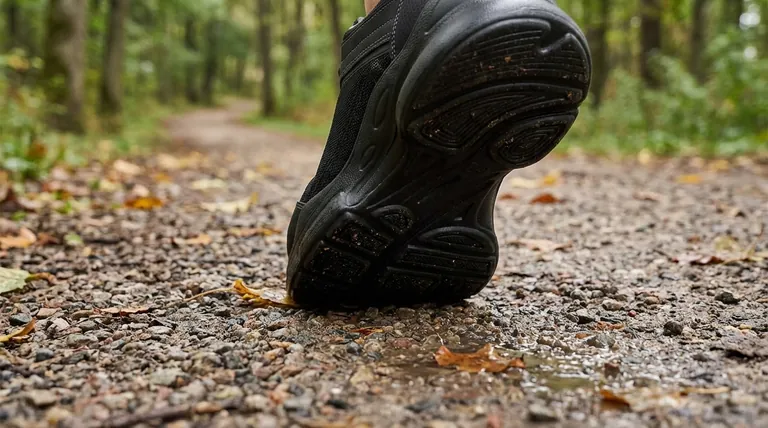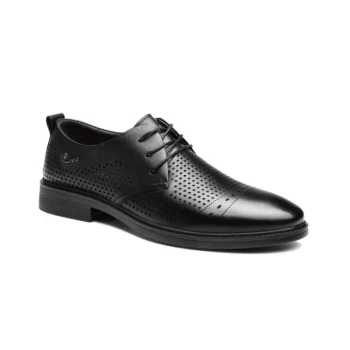In short, the outsole is the bottom layer of your walking shoe. It is the part that makes direct contact with the ground, designed with grooves and treads to provide essential traction and durability for a safe and stable stride.
The outsole’s primary job is to provide grip and withstand wear from the ground. This function is distinct from the midsole, which absorbs impact, and the insole, which provides direct comfort to your foot.

A Shoe's Foundation: Outsole, Midsole, and Insole
To truly understand the outsole's role, it's helpful to see it as part of a three-layer system that works together to support your walk.
The Outsole: Your Connection to the Ground
The outsole is the durable, outermost layer of the sole. Its key purpose is to create friction between your shoe and the walking surface.
This is achieved through specific patterns of treads and grooves molded into the material, typically a hard-wearing rubber, to prevent slips and provide a confident grip.
The Midsole: The Shock Absorber
Located between the outsole and your foot, the midsole is the shoe's primary cushioning engine. It is often made from materials like foam, gel, or air pockets.
The midsole's main function is to reduce the impact and stress on your joints each time your foot strikes the ground.
The Insole: Direct Foot Comfort
The insole is the soft layer inside the shoe that your foot rests directly upon. It provides the final layer of cushioning and is crucial for arch support.
Many insoles are removable, which allows you to replace them with specialized orthotics or simply take them out to be cleaned or aired out.
Why Outsole Design Is Critical for Walking
While the midsole gets a lot of attention for comfort, the outsole's design directly impacts the safety and efficiency of your walk.
Traction Dictates Stability
The specific pattern of the outsole's treads determines how well the shoe grips different surfaces. A well-designed pattern channels water away and provides multiple edges to bite into the ground, ensuring stability on pavement, trails, or wet surfaces.
Durability Determines Lifespan
Because it constantly scrapes against the ground, the outsole is built from the most abrasion-resistant materials in the shoe. A high-quality outsole ensures your shoes last longer without wearing down unevenly, which could alter your gait.
Flexibility Enables Natural Motion
A good walking shoe needs a flexible outsole. This allows your foot to roll naturally from heel to toe through each step, preventing a stiff or slapping motion that can lead to fatigue.
Understanding the Trade-offs
Choosing the right outsole involves balancing competing priorities. There is no single "best" design for every situation.
Deep Treads vs. Smooth Surfaces
Aggressive, deep treads are excellent for traction on uneven trails but can feel clunky and wear down quickly on smooth pavement. Conversely, a flatter outsole is great for roads but offers poor grip on loose dirt or gravel.
Durability vs. Weight
Harder rubber compounds increase the shoe's lifespan but also add weight. Lighter, blown rubber outsoles offer more cushioning and flexibility but will wear out significantly faster.
Making the Right Choice for Your Walk
Focus on where and how you walk to determine the right outsole for your needs.
- If your primary focus is walking on sidewalks and roads: Look for a durable, relatively smooth outsole with shallower grooves for consistent ground contact and flexibility.
- If your primary focus is walking on park trails or in wet conditions: Prioritize an outsole with a more defined, multi-directional tread pattern for superior grip and safety.
- If your primary focus is maximum comfort: Acknowledge that the outsole provides traction, and direct your attention to evaluating the shoe's midsole and insole for cushioning properties.
By understanding the outsole's specific role, you can better assess how a shoe will perform for your intended use.
Summary Table:
| Shoe Layer | Primary Function | Key Feature |
|---|---|---|
| Outsole | Provides traction and durability | Tread patterns & rubber material |
| Midsole | Absorbs shock and impact | Foam, gel, or air cushioning |
| Insole | Offers direct comfort and arch support | Removable and often customizable |
Need High-Quality Walking Shoes for Your Customers?
As a large-scale manufacturer, 3515 produces a comprehensive range of durable footwear for distributors, brand owners, and bulk clients. Our production capabilities encompass all types of shoes and boots, including walking shoes with outsoles engineered for superior traction and longevity.
Let us help you provide the perfect footwear solution. Contact us today to discuss your manufacturing needs!
Visual Guide

Related Products
- Wholesale Breathable Training Shoes Custom Athletic Footwear Manufacturer
- Premium KPU Athletic Safety Shoes for Wholesale
- Durable Rubber-Soled Utility Shoes for Wholesale & Custom Brand Manufacturing
- Lightweight Breathable Training Shoes for Wholesale & Custom OEM Manufacturing
- Wholesale Lightweight Cushioned Athletic Sneakers for Custom Bulk Production
People Also Ask
- What are the benefits of athletic-style work shoes? Boost Comfort and Safety for Your Team
- How do non-slip athletic shoes differ from regular athletic shoes? Discover the Grip Technology
- What are the benefits of breathable materials in work shoes? Enhance Comfort & Health for Your Workforce
- How do athletic shoes with non-slip features differ from regular ones? Discover the Grip Advantage
- Does more ground contact area mean better support? Unlock the Secrets of Stable Footwear



















